On Pop Culture Werewolves – Creature Designs, and Underworld’s Massive Influence
So you’ve probably heard me go on and on about different werewolf designs – and different werewolf appearances in folklore, like right here – and, generally, my… uh… complicated relationship with pop culture werewolves. Well, here’s some more on that. But not a whole lot on that second part, because I don’t want to piss anybody off.
Specifically, here is the answer to a great big question: why do werewolves for the last several years – say, give or take a decade or two – look… the way they generally do?
There’s a lot of Hollywood behind this again.
Warning: THIS IS AN EXTREMELY LONG (and impassioned, and hopefully informative) POST.
Also a disclaimer: please note that while I may occasionally come off as extremely jaded and cynical (and I generally do not have a good relationship with 90% of werewolf media), I actually do like some werewolf media, and my ranting about werewolf designs and such is not necessarily a condemnation of everything that used any similar design(s) or design elements.
You know the ones I’m talking about…
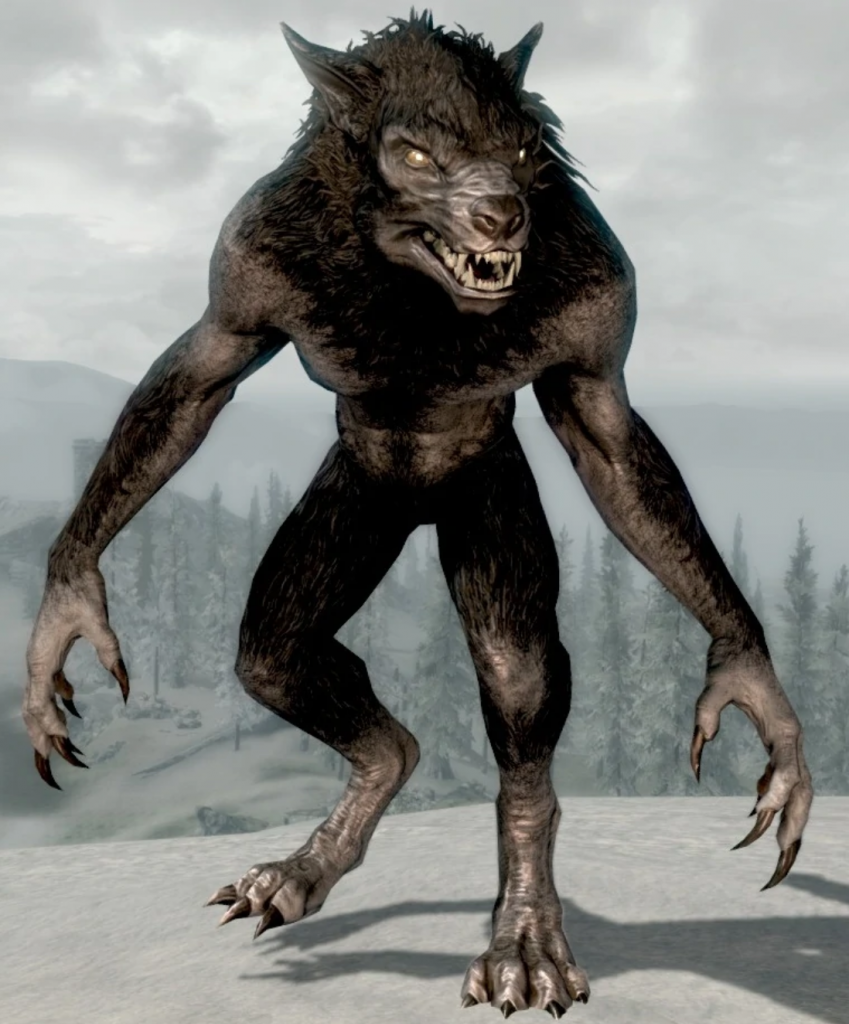
While writing my breakdown on dragon designs of recent years, I realized I need to write another one of these: a breakdown on werewolf designs over the last few years. Or, should I say, last long while. Because let’s face it: they generally all look very similar, from films to video games – and this very much does include video games.
Even just google image searching “werewolf” will yield literally thousands of results that use extremely similar designs – that, frankly, don’t necessarily take a lot from actual wolves.
So how’d this happen?
Movie Werewolves Have Always Looked Gross
As I’ve discussed many times before, like with silver and full moons (but that is absolutely not all they’ve influenced in terms of werewolves), Hollywood and its conception of werewolves – or, I should say, Curt Siodmak’s conception of werewolves, specifically (the writer of The Wolf Man, the original 1941 film) – has had massive influence over werewolves and everybody’s view of them.
However, in older werewolf movies, there was a pretty standard formula: there is, generally, one werewolf – that werewolf bites the protagonist, protagonist becomes werewolf, protagonist has inner conflict and horror situations and kills people, protagonist gets dramatically killed while in werewolf form in the end of the movie. The Wolf Man started this formula too, and you can find it everywhere.
Then there were a few other influential movies, such as An American Werewolf in London and The Howling (ask me my opinion on either of these but especially The Howling at your own risk).
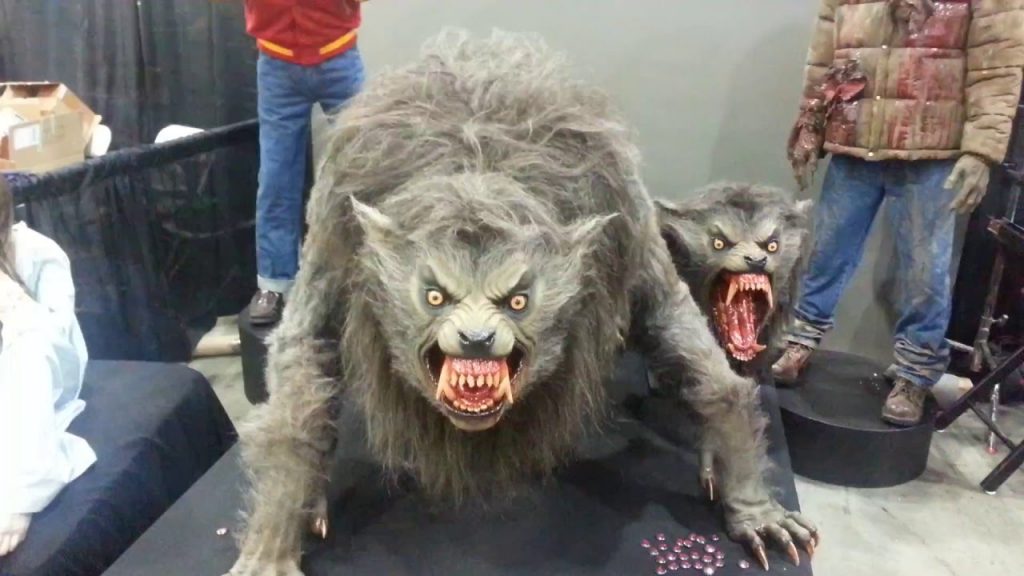
As you can see, movie werewolves have for a long time had this concept that they have to be hideous and weird and creepy and gross instead of being “just wolves” like in 90% of the folklore. Sometimes they barely resemble wolves, if at all. At least this one has fur, though, and a wolfish nose and teeth. Gotta give it that.
That’s been a thing for a while. But it really, really caught on in the 80s. Before the 80s, werewolves were mostly wolf-men like in the original 1941 film, perhaps due largely to budget reasons (makeup vs. animatronics and/or CGI).
So now we have the start of the basis for “gross werewolves” that don’t really favor wolves. This was, in some cases, done in part to try to make the werewolves look “more human” despite the fact that they are people who turn into wolf-men/wolves and the whole point is the transformation.
It’s important to bear in mind that while the Underworld movies had tons of influence, but movie werewolves have always had some features in common for years, like a general lack of fur and often the lack of a tail, due in no small part to budget reasons, because most werewolf movies are cheaply made. By the time you spent all your money on a decent werewolf head/mask, you don’t have any money left for something like fur and a tail.
The lack of a budget started setting a standard for werewolf designs. In a way, werewolf designs simply adopted the fact that no one wanted to throw money at a werewolf production.
But more on that later. For now…
Underworld (2003)
I will try not to impart my opinions on the Underworld movie or franchise as a whole here, as my opinions are incredibly unpopular and I am essentially unable to part with them to literally anyone and still have anyone like me. I’m always told to be honest and write opinion pieces, but that never actually holds up. Needless to say, as you can probably tell, I am not a fan of the Underworld movies. I could give you many, many reasons why, and they aren’t even limited to the werewolves sorry the lichen lycans, but that’s not what this post is about.
I will openly acknowledge I absolutely adore the use of practical effects and suits and animatronics in the Underworld movies, though. They get huge respect and props from me for the way that they made these suits and used animatronics etc.; it’s extremely impressive and no one would probably bother with that today, they would just throw CGI together. I’ve consumed every single behind the scenes thing of these movies just to hear more about how they made these practical werewolves, so I certainly know the source material and all their design decisions inside and out. The way they created the werewolves to be put on camera is extremely cool.
There; I said something nice. It’s not like I don’t respect the way they created these films.
This post, however, unfortunately isn’t about the practical film effects and how amazing they are – it isabout the massive influence that Underworld has had on virtually all werewolf media following its release (with rare exception, like Twilight and its separate influences, but that’s for another post).
Even though, now, we are seeing less of the general Underworld influence insofar as the werewolves vs vampires thing is going (more on that later in this post), it’s still had a hand in so many things we see in werewolf media today – all of it, across the board. Movies, games, everything.
So, first, let’s talk werewolf designs.
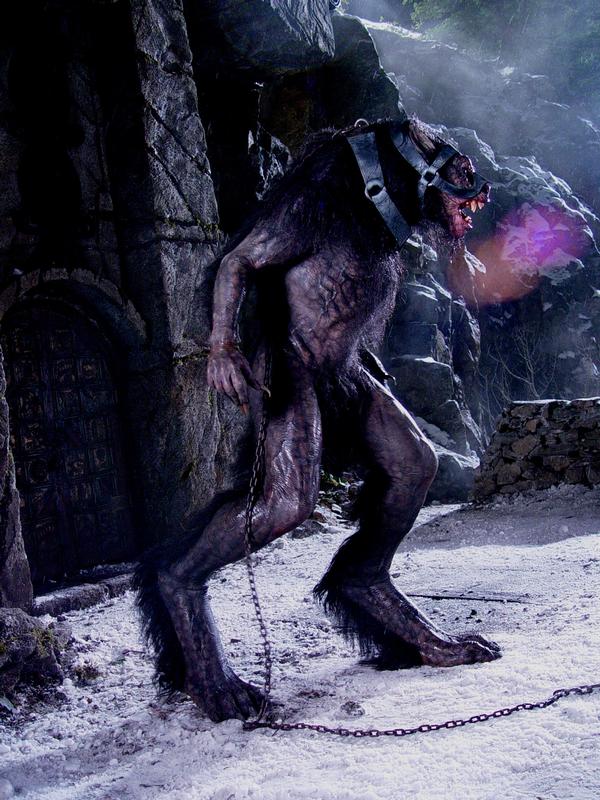
In a way, it’s a similar situation to Reign of Fire, which I covered in my dragon design post I linked to before…
The filmmakers wanted a “different” sort of look for their werewolves, because they claimed to have seen other, more wolfish looks so often elsewhere (gee), and they wanted to be more unique (our werewolves are different). That’s all well and good. That’s fine.
But then, just like Reign of Fire, everyone copied them.
Just to fill you in real quick in case you don’t already know, in the Underworld movies, there are two primary types of werewolves: werewolves and Lycans. Werewolves are the less “evolved” and more dumb and animalistic ones that never turn into humans again, and they have more wolfish/animalistic heads. Lycans are the “more evolved” ones that look more like big, mangy apes with digitigrade legs and vague indications of wolfishness.
It’s also noteworthy that, in Underworld – also kind of like the big animalistic dragons in Reign of Fire – the werewolves are supposed to be the product of a virus that mutates and is all gross and disgusting and non-specific, so making them straight-up ugly was a conscious design choice, because apparently things that aren’t hideous can’t be scary (that was sarcasm), which is an extremely common conception today, especially among modern fantasy and paranormal.
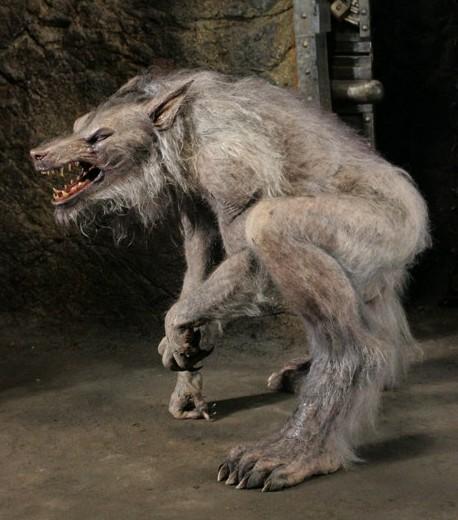
Lack of a Tail
I want to point out that Underworld did not specifically “create” this design choice, because most movie werewolves haven’t had tails for years and years (there are countless examples before the Underworld movies released), but I do think that Underworld really had a hand in etching this deep into people’s brains and made them think it was “the way werewolves are,” that “werewolves aren’t supposed to have a tail.” The simple reason being that Underworld was so massively, disproportionately popular as far as werewolf movies/media is concerned, so everyone thought it would be a good idea to copy them.
Here’s what really, really bothers me about this design choice: on a personal level, I think werewolves look much better with a tail if they have a design that has a wolfish head and digitigrade legs.
On a different level, however, it bothers me much more simply because now everyone likes to say that “werewolves in folklore didn’t have tails.” Yes, werewolves in folklore did have tails, because they were generally turning into just giant wolves and also because they were specified in multiple sources that having a tail is an integral part of identifying a werewolf, especially – in later years – over a witch in an animal disguise.
So if that’s a conscious design choice, fine, whatever. But don’t go around claiming that werewolves “aren’t supposed to” have tails or “didn’t have tails in folklore.” Or that “werewolves don’t have tails,” because first of all, werewolves aren’t real, and second of all, from a folkloric standpoint, that is so flatly untrue that it hurts my soul. Werewolves in folklore do have tails. They simply do and it’s one of their defining, inhuman features that, in the past, made them scary, which modern audiences don’t seem to understand.
Now, in the original The Wolf Man movie, the werewolf didn’t have a tail, obviously. This followed up for a lot of things in Hollywood; who knows particularly why. It’s obvious why he didn’t have one in the original movie: he would’ve looked ridiculous with the design he had and the budget they had available. He was far more human than wolf.
Tails are extremely hard to put onto a suit thanks to all their independent movement, or to put convincingly into CGI if they have fur. This is something I’ve heard a lot from a lot of filmmakers. Fur is incredibly difficult and expensive to render. If your monster has little to no fur and/or an ugly stick for a tail or no tail at all, it’s a lot easier on your budget to make the slick skin and bones thing look believable.
It’s also a horror thing: horror people think putting a tail on a werewolf makes it look silly (especially if it isn’t just a rat tail). Or, also, this could be a retroactive opinion that was taken up after all the other reasons why werewolves weren’t designed with tails in Hollywood, and now they are trying to justify saving time and money while also convincing themselves that it looks better. Some movies did make a conscious choice not to have a tail specifically for simplification and budget reasons.
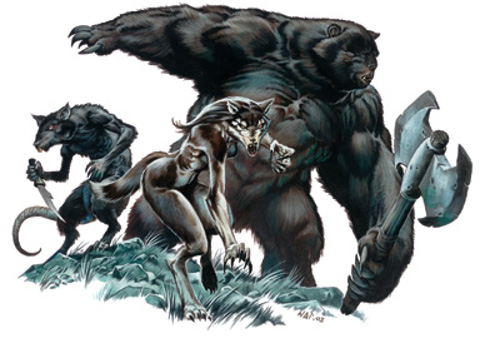
It was kind of assumed in the past that werewolves had tails, by design. Now, it is the opposite: it is assumed that werewolves don’t have tails, by design.
After Underworld, we saw the tailless design really start leaking over into other media, such as video games and even tabletop RPGs.
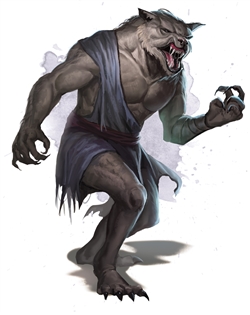
Long, Flat Ears/Ears on the Sides of the Head
This is quite possibly the biggest thing that Underworld really popularized…
Ears on the sides of the head instead of the top of the head. Like so:
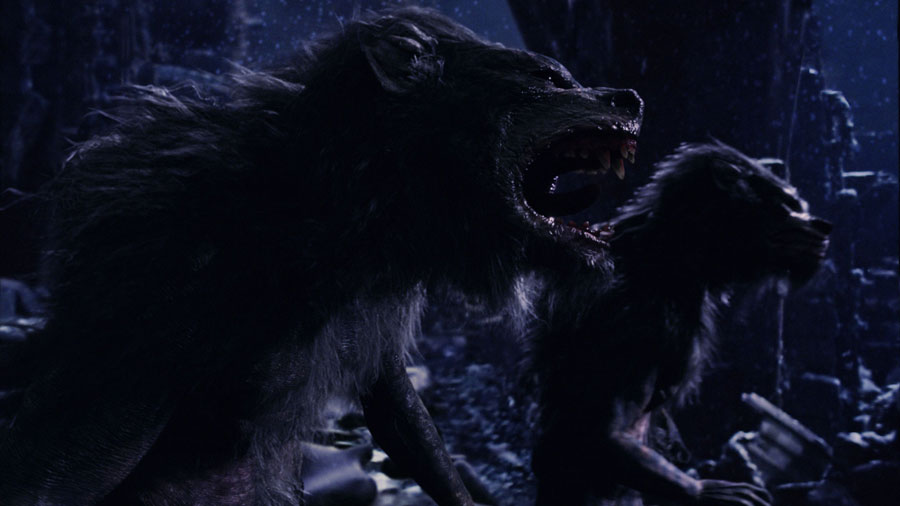
This is a mid-transformation shot, so not the best, but there are examples throughout this post. Notice how their ears are on the sides, not on top, like a wolf’s? And they also slope downward, instead of pointing upward, and are often rather long and kind of floppy.
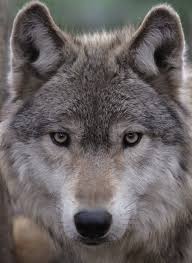
Yeah. You see this literally everywhere now, really. There are occasional rare exceptions, but it’s hard to find much media really going for just the pure wolf ear look these days. Presumably, this was a design choice to put them in a more human-like ear position, because today people seem to prefer designs that lean more toward freaked-up human animal mutant instead of a wolf-man.
Blunted Muzzles and Unusual Muzzles
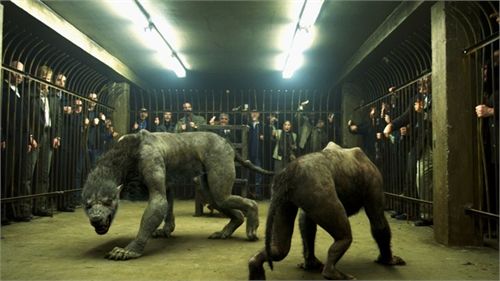
It’s pretty apparent that Underworld helped a lot in popularizing the design of a more ape-like, blunted sort of muzzle for werewolves. It can be seen in so many places these days.
The other Underworld werewolf design, of the longer muzzle that still isn’t exactly like a wolf’s (like William’s up there; the white Underworld werewolf), can also be seen in a lot of media.
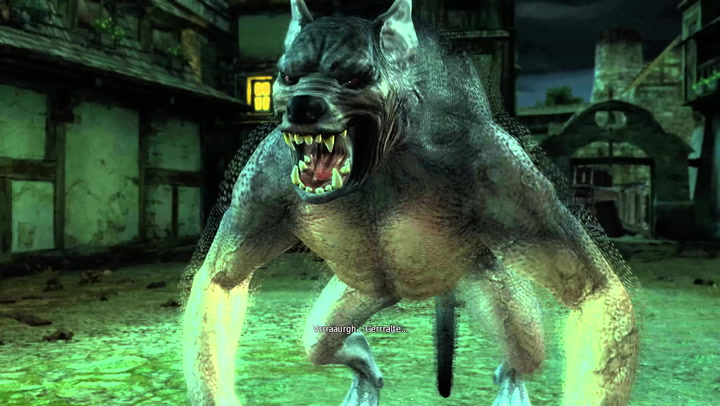
50 Shades of… Dull Greyish Fur
In the popular trend of removing color from absolutely everything, all werewolves are now various shades of dull grey. Don’t get me wrong, this has long been the case and the general assumption, but at least you used to see some brown, black, and white werewolves sometimes. Good luck finding one that’s truly brown, black, white, or any assorted wolf coat patterns or colors today. They’re all just grey or some kind of off-white grey or a slate grey that’s slightly darker so they classify it as black.
They basically never come in actual wolf fur colors or patterns – which wolves have plenty of, and they don’t often come in solid grey. They have quite a bit of brown. But anyway…
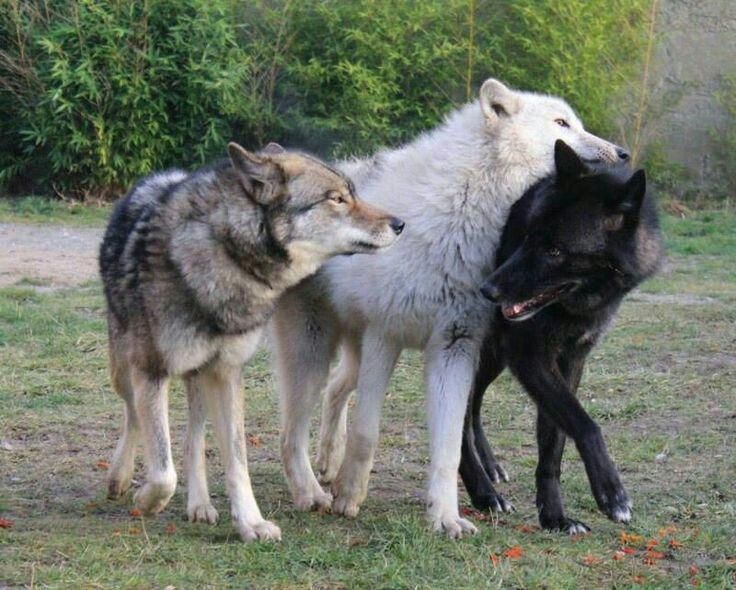
Mangy/ragged Look, Bald Spots, Body Hair Fur Patterns
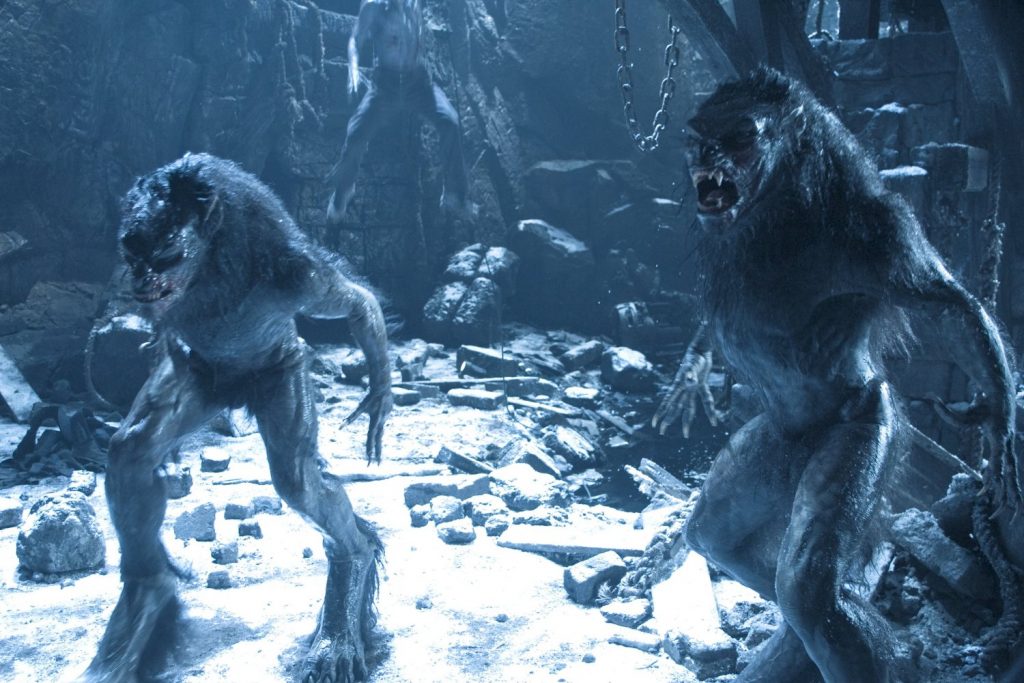
Werewolves kind of lost their heyday of actually having much fur. Most werewolf designs seen especially today don’t really do much in the fur department. They also lean toward having kind of a mangy, ragged look and/or bald spots (especially a bald face and ears) and what little fur they have is wiry and in a kind of human body hair pattern, in a line up their torsos and spreading out over their chests.
This is seen pretty much everywhere now. And no, it isn’t very wolfish. Wolves are very, very, very fluffy and furry. I guess I get it not to want to be too fluffy/furry if you’re going for hardcore edgy horror – in part this is also a budget thing, in the case of a lot of werewolf movies, because fur is expensive whether it’s rendered or not and whether it’s fake or not.
But now it’s seriously caught on, and even Dungeons & Dragons have pretty much nixed their truly wolfish werewolf designs from previous media.
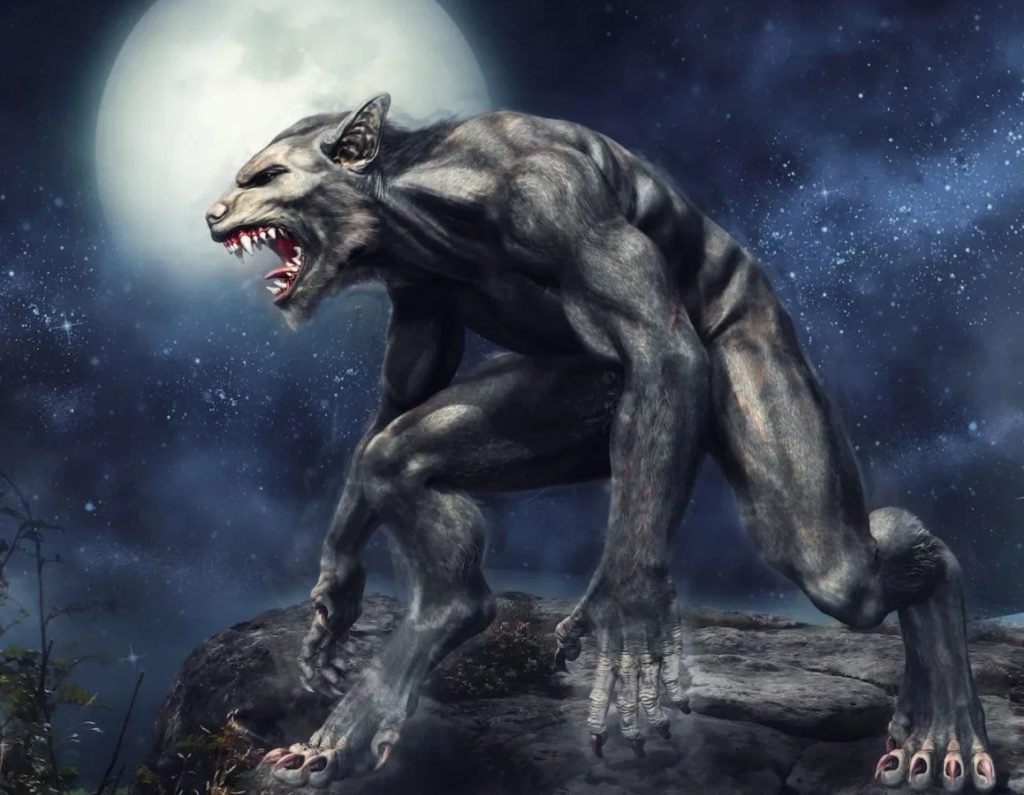
No Howling, Ever – Roar Instead
Look, don’t get me wrong – I love an awesome werewolf roar. I love that werewolves in media roar. It’s bestial. It’s fearsome. It’s fantastic. You will never hear me complain about a roaring werewolf. Roaring is fine, roaring is awesome. As long as they don’t bark.
But… have you noticed that werewolves in media almost never howl anymore?
Sure, it was fairly rare to begin with, but now it’s almost unheard of, especially to actually see them doing it on-screen. If it ever happens, if they ever actually howl howl instead of just roaring or making weird, deep noises, it happens off-screen and you just hear it. (P.S.: God the first season of Teen Wolf is so good)
I really don’t understand this. You have to download mods to ever howl in Skyrim, for instance. The howl is a truly unique, iconic sound of the wolf alone and is bursting with ranges of emotion – rage, loneliness, sadness, hunger. It can represent so much. It’s impossible to describe the range of emotions that goes through me, at least, when I hear a wolf howl. Wolf howls are as beautiful as they are haunting – and chilling.
Why not let werewolves make the iconic sound of the animal they supposedly turn into, at least partially?
Because, as a whole, media is trying to steer werewolves away from resembling wolves at all? It would fit the bill.
————
Now let’s pass out of design choices just a little bit and into some general story concepts and elements…
Dumb Plague Rats/Cannon Fodder
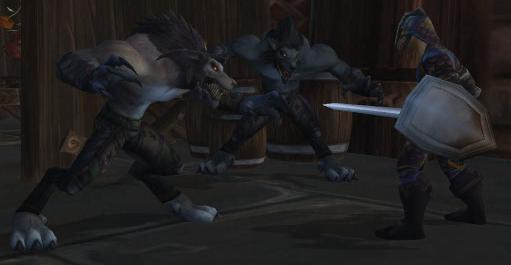
“Objective: Kill 80 Worgen.”
Wow. Cool. So we just have to go kill 80 of them now, literally. They are complete and total cannon fodder. You literally kill them with cannons. (This is from World of Warcraft)
It’s become massively popular today to turn werewolves into, essentially, plague rats. To make them the equivalent of the zombie plague.
Underworld didn’t exactly help slow this down, given Selene slaughters werewolves with a flick of her finger. Dozens of them at once. Effortlessly, in stylized sexualized violence fight porn where the werewolves are just stupid throwaway baddies that are easily dispatched.
There’s another word that’s become associated with werewolves that I intensely dislike: “extermination.” Werewolf exterminations. This has happened across all kinds of media. The brothers in Supernatural hope for “run of the mill” werewolf exterminations. Video games take you on werewolf extermination quests. Even Elder Scrolls Online, in a setting that ordinarily has awesome werewolves that are treated right (ESO completely ignored ES werewolf lore and did their own thing), has “werewolf infestations.” Also, hi, Bloodborne.
This happens so much in so many things. Werewolves shouldn’t be plague-carrying rodents that are “infestations” to be “exterminated.” But, you know, I guess that’s just my opinion, man.
They’re Not Werewolves, They’re [name]
See how ours are scary and different and aren’t corny and dumb because we don’t call them “werewolves”!?
Underworld went a long way to nudge further the concept of “werewolves are corny, we have to call them something differently for anyone to take them seriously.” True, this is a general Hollywood problem – with werewolves and all sorts of other mythological creatures – but you’ll notice it doesn’t tend to happen with vampires the way it does werewolves (even as Count Chocula offers you his cereal and The Count helps you count on Sesame Street, because they are so horrifying). And, I’ll be real blunt here, it offends my sensibilities.
I just recently got another dose of the “well the word ‘vampire’ is scary but ‘werewolf’ doesn’t give any terrifying implications.” Okay, how about no? How about we change that, if that’s what people are really thinking?
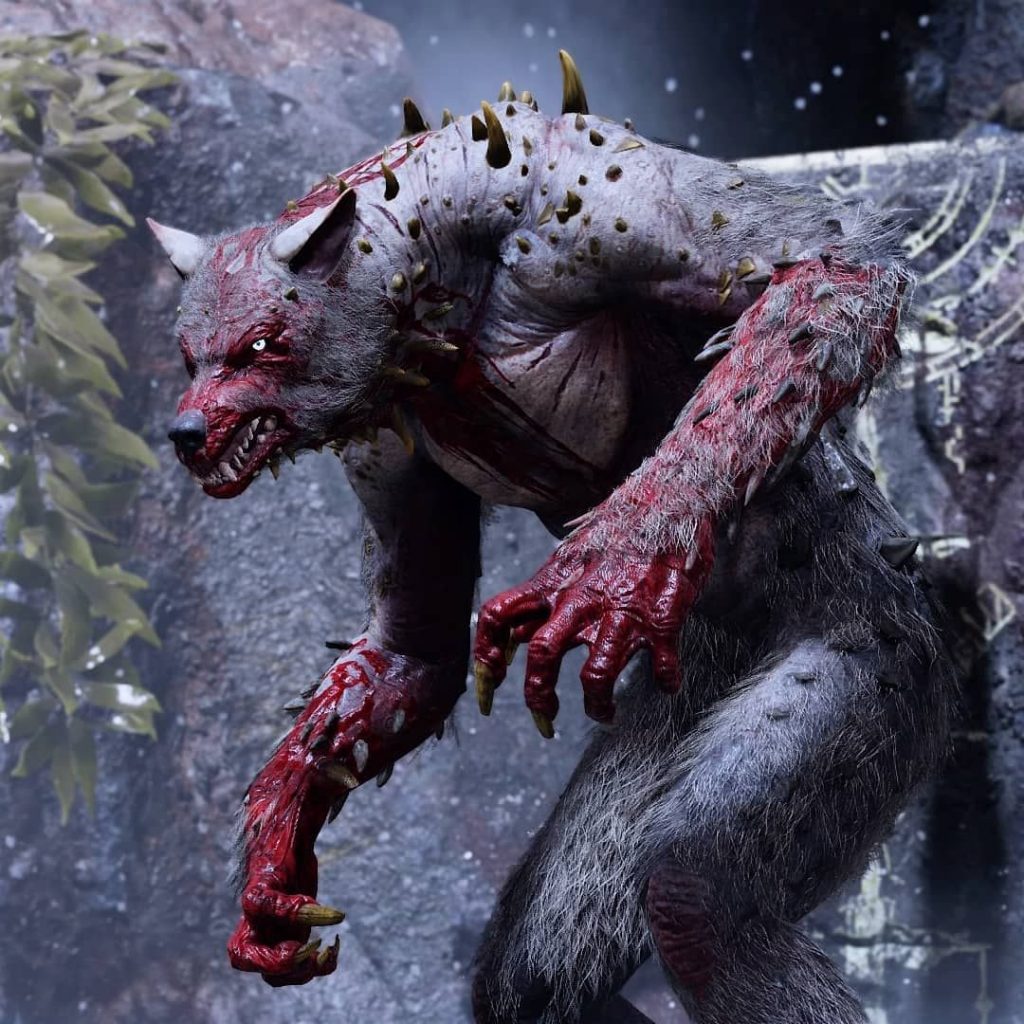
I can’t stand the “we can’t call werewolves ‘werewolves’ because that’s corny” movement. It angers more than I can even put into words. Call your werewolves what they are: werewolves. It’s a great word. It’s my favorite word. It’s a fantastic word. And let me translate a lot of variants for you: “werekin” means “man-kin,” “weres” means “men,” etc. “Lycan” sounds like a greenish composite lifeform that grows slowly on static surfaces, not a lycanthrope, not a werewolf, not a terrifying monster.
Werewolves should be called werewolves. Underworld helped nudge this along, so that’s why this is here. The concept of werewolves, insofar as writing is concerned, should exist in a vacuum without trying to address the presumptions of every (entirely theoretical and presumptive, by the way) reader who may or may not be thinking “oh werewolves are corny” – and if they are thinking that why would they be approaching a work about people turning into animals, anyway, because just giving a cheesy name to something that is obviously a werewolf couldn’t possibly pull the wool over the eyes of too terribly many people with two brain cells to rub together.
Werewolves vs Vampires
This has, thankfully, kind of died out in recent years, but around the time of the Underworld movies’ heyday there was a massive upsurge of werewolf vs vampire media. Underworld gave the concept a massive popularity boost, as I discussed in-depth in this post here. (And to address lots of people who decided it’d be cool to flame me over it: yes, I acknowledge World of Darkness, but I didn’t credit it as popularizing this concept because Dark Shadows started it and then Underworld popularized it. When I say “popularize,” I am referring to the common everyday people who went to see the Underworld movies because they wanted to see Kate Beckinsale in tight black leather and weren’t, in the early 2000s especially, playing tabletop and definitely weren’t actually interested in anything about werewolves or vampires except vampire Kate Beckinsale, again, in her tight black leather. I’ve never not acknowledged WoD, but it simply isn’t as mainstream as the Underworld movies were, because Underworld reached a very wide audience for a while and that’s why we saw so many sequels cranked out at first. This is not to be taken as an endorsement of Underworld or bashing of WoD.)
Warcraft: The Great Worgen Redesign
And now to get to a massive sore spot for me: the worgen in World of Warcraft.
Originally, worgen had different lore and a different appearance, before the release of the Cataclysm expansion pack…
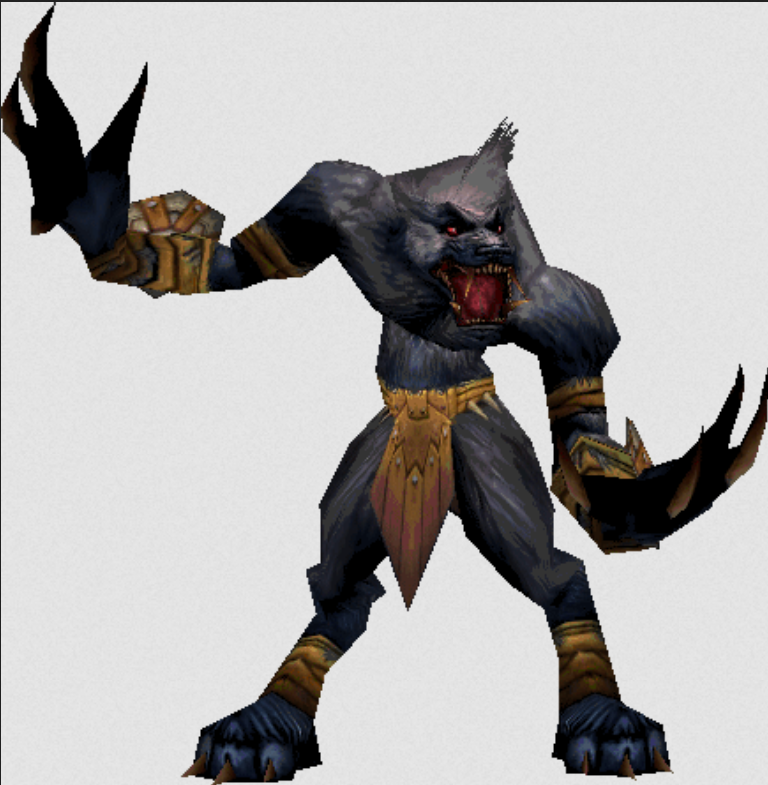
And they were just random throwaway enemies, by and large.
Then, Blizzard did something no one expected (but I had always begged for and also never really expected) – they made worgen playable. Unfortunately, I could criticize all their decisions related to the worgen until hell freezes over, but I of course still play as them. Not only are worgen British stereotypes (not even actual British people, just… British parodies that are completely ridiculous; the Kul’tirans are the actual British people) and also fall directly and shamelessly into the category of “throwaway plague rat werewolves” as well as “our werewolves are different” and “don’t call them werewolves,” among other categories, they got a complete and total redesign when they became playable…
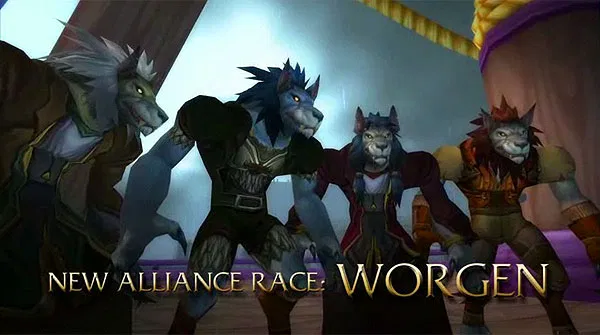
Wow! Cool design! Sure, it looks kind of cattish, but Blizzard has never actually known what wolves look like anyway, at least as far as the wolves in World of Warcraft are concerned. Their ears are wolfish, and that’s pretty great and extremely rare today.
But then someone decided that these designs weren’t horror-ish enough. Which is fair, they could’ve used maybe a teensy bit more horror and a lot more wolfishness, but still, they were great. They were very expressive, both in face and ears, and had wolfish ears and wolfish muzzles.
Someone didn’t like any of that.
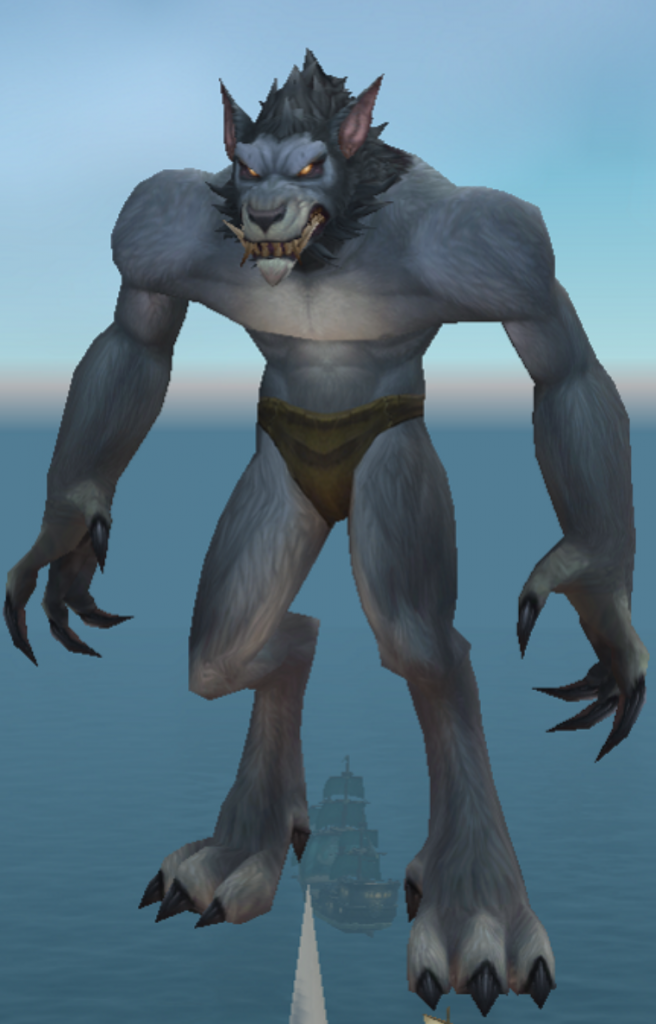
So they took it too far. They also slapped their ears on the sides of their head instead of on top and removed any option for mane colors or designs unless you want a few ugly, scraggly braids (though the big spiky manes did make them look rather lionish, but it could’ve worked with some more improvements), solidifying their boring greyness while also solidifying their face shape as something more non-wolfish and their expression in an eternal snarl – and their nose is a giant cat-shaped nose.
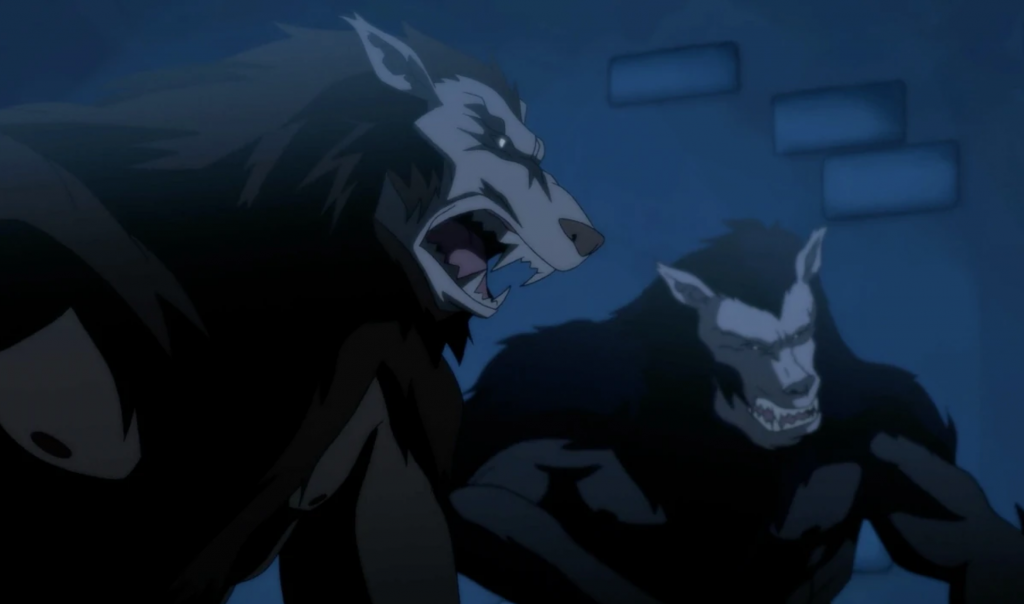
Somebody watched some Underworld, really.
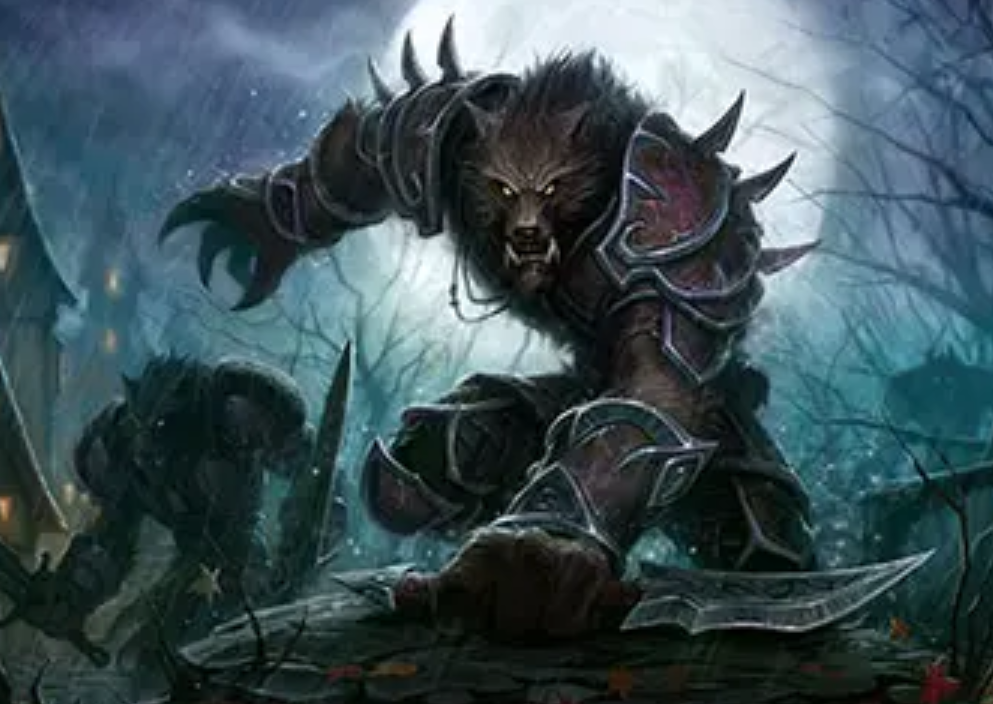
Customization options included: what shade of grey would you like to be? Light grey, slightly darker grey, lighter grey, a brownish grey, or a different brownish grey? Female worgen got a few more colors than that.
Ten years or so later, after many promises of upgrading the awful worgen model, players were given this instead.

I’m not posting the female worgen here because they are just designed purely to be sexy and appealing; the males are much more in line with ugly werewolf designs.
So this is what we ended up with.
And now, even later again, worgen players are still upset at the downright pathetic amount of customization available for the worgen (especially the male worgen) and how Blizzard won’t address anybody’s requests or the absolutely massive public outcry to give worgen the option to have a wolf tail. We do have a few more fur colors coming, and that’s literally it, but we still don’t really have any actual wolf fur colors (wolves don’t have white paws unless they’re just solid white) or… well, anything else.
Oh, and the male worgen ears are totally broken and don’t emote, because you can’t emote with big, long, flat ears on the sides of the head. The alpha models emoted with their ears, though, and that sure did add a lot.
Anyway, I will shelve my worgen player concerns for now.
A Few Examples from Media
The list for this is nigh upon endless. Look at almost any even semi-recent werewolf media and you’ll see at least a few influences of all the things I just mentioned. Heck, just google image search “werewolf” and look at the various art and renders.
But here are a few examples…
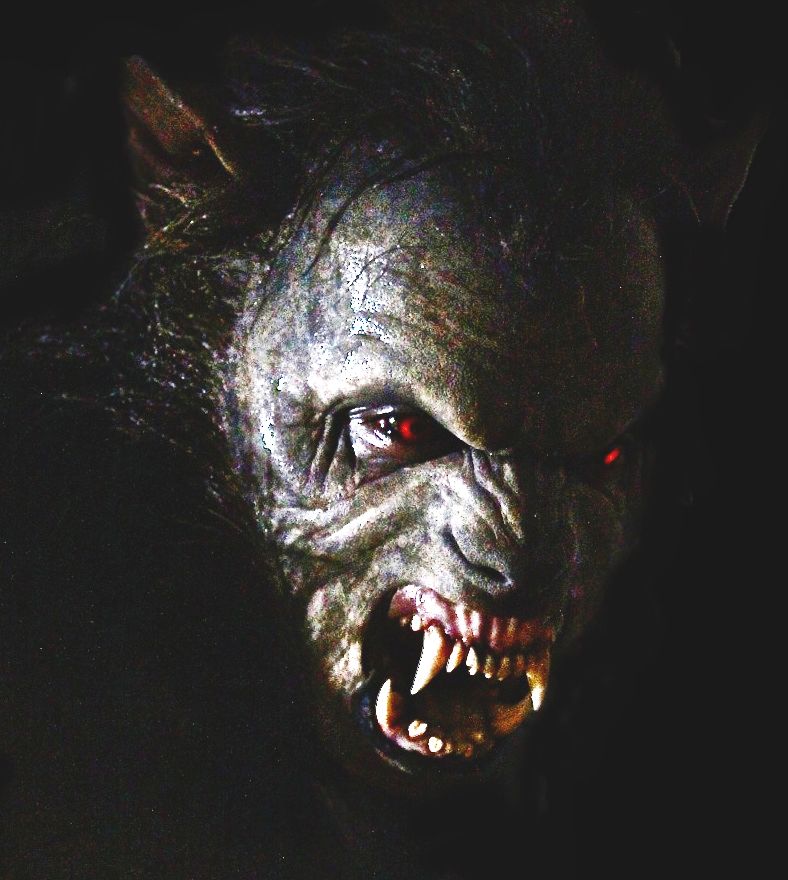
Please note this is just a few examples. There are many, many more than this. And now “lycan” is pretty much interchangeably used in media for “werewolf,” and that was largely if not entirely from Underworld. So there’s another one, too, not just the design and story elements!
- MTV’s Teen Wolf (2011-2017), TV show – Especially the design of the Alpha from the first season, who also made a few appearances later, as well as the Beast of Gevaudan in a later season.
- Harry Potter and the Prisoner of Azkaban movie (2004) – This werewolf makes me sadder than you could possibly imagine. I waited my entire childhood to see this werewolf. And they openly defied the description in the books and we got – well, what we got.
- The Chronicles of Narnia: Prince Caspian movie (2008)
- Cabin in the Woods (2012), movie
- Werewolf: The Beast Among Us (2012), movie
- Goosebumps (2015) – As a side note, please never, ever mention this movie in my presence.
- Being Human, TV show – Both the American and British versions of this show had influences, though the American one more so.
- Grimm, TV show
- Dragon Age: Origins, video game (2009)
- World of Warcraft and Heroes of the Storm, video games
- The Witcher games
- Skyrim (2011), video game – Adopted a lot of this look (the werewolves in Elder Scrolls III: Morrowind – Bloodmoon didn’t have that look and looked much better, IMO, but at least they let the Skyrim werewolves keep their tails)
Hopefully this shone a light on a few things.
Long story short, Hollywood doesn’t like it when werewolves look like wolves except in the most minor of ways, generally speaking, and this has started leaking into other media lately as well and also Underworld influenced werewolf media after it more than you might realize.
Also, in conclusion…
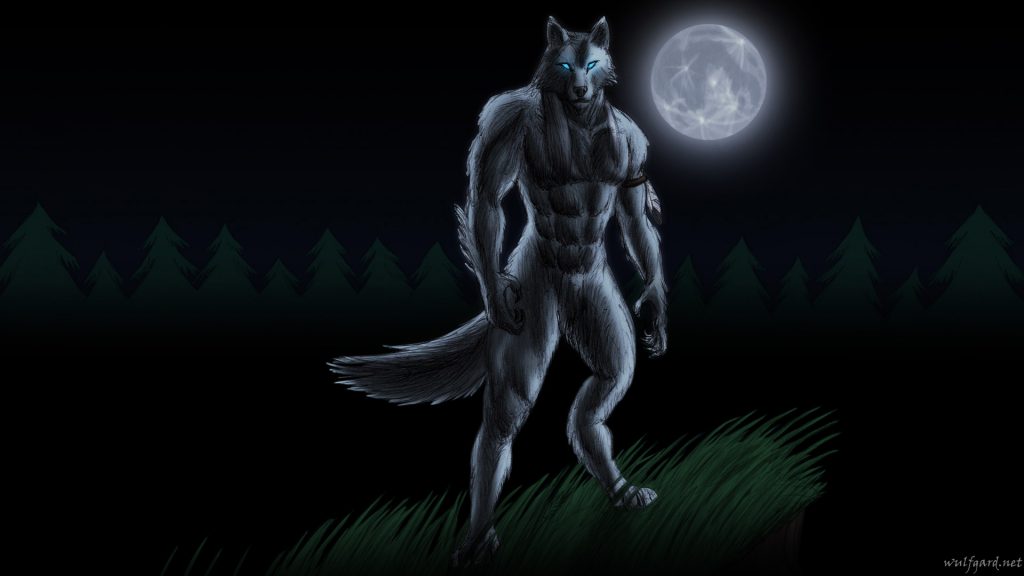
I don’t know why we can’t have werewolves that look like wolves but are still scary. It isn’t “corny” to have a werewolf that looks like a wolf. Some of the most terrifying things in nature are incredibly beautiful, like wolves, with their mystique and absolute majesty.
Or like a bear. Until it’s eating you. Alive.
Some of the best scares come from something that could appear majestic otherwise. And what could man possibly fear more than the untamed beauty and savagery of nature? You can’t design a better creature than just… a wolf. Their “design” doesn’t “get old.”
After all, wolves scared us first.
Warning: some strong opinions below this line.
I have to just semi address this, though, okay?
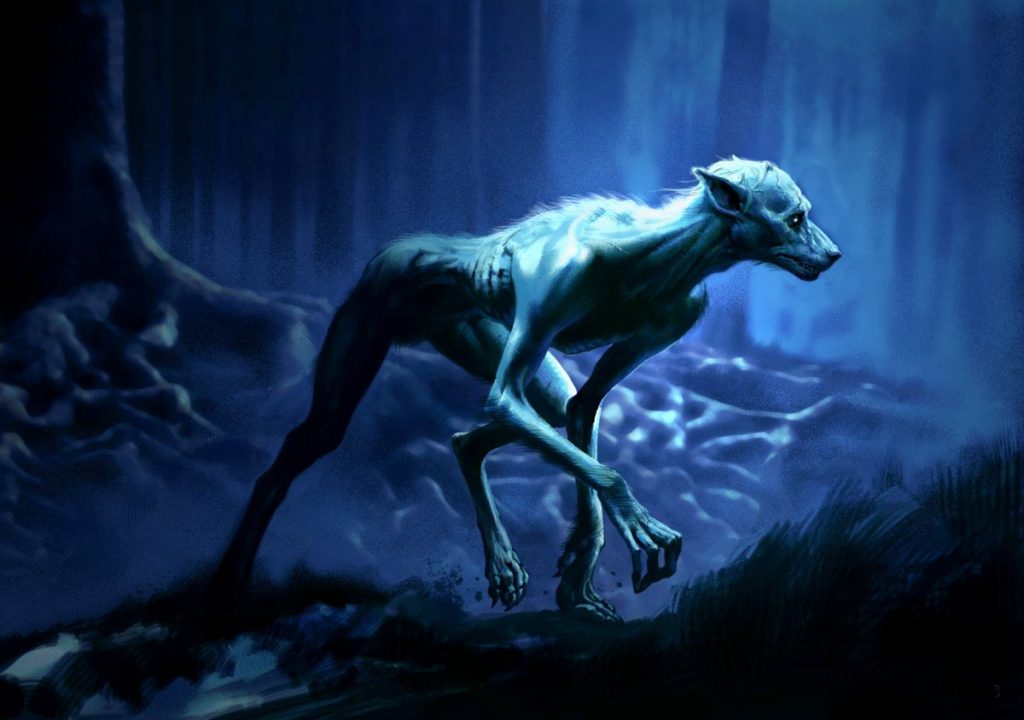
Let’s not even talk about this one. I don’t even know where to begin. Everything is terrible. What even is this?
Notice the ears, though, at the very least. Those ears… and what the heck is up with those sad teeth? Or… or any of it?
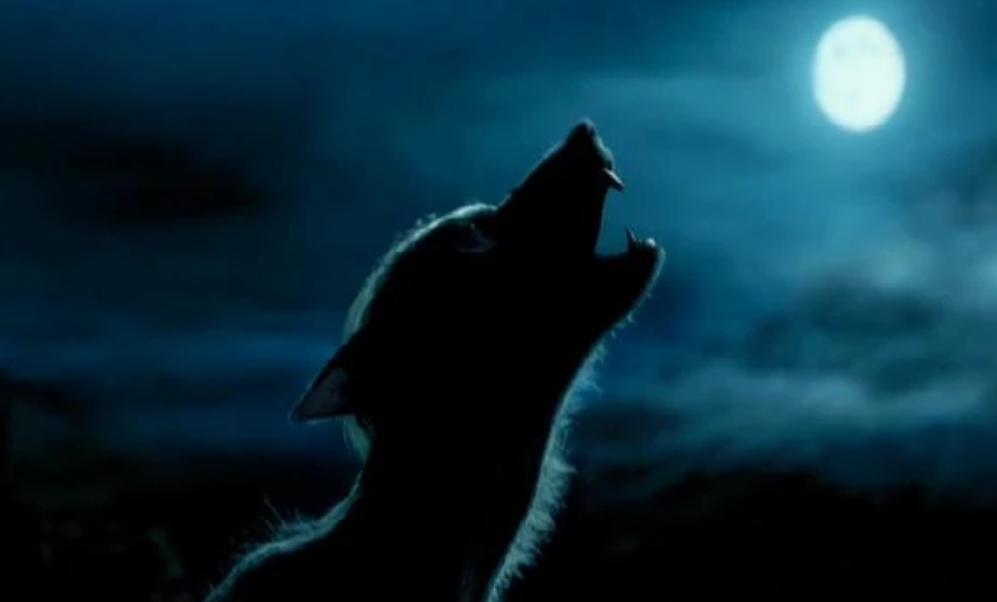
Sigh.
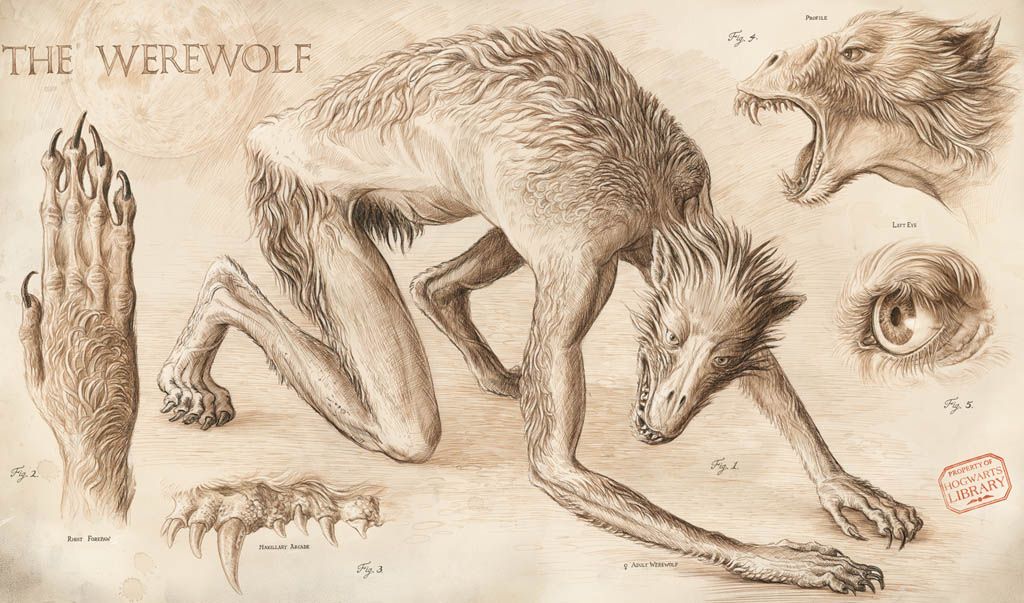
And this is from the Harry Potter and the Prisoner of Azkaban illustrated whatever illuminated book thing.
WHAT EVEN IS THIS OH MY GOD? WHAT IS IT? THIS IS NOT A WEREWOLF. It doesn’t even look like a wolf at all. It doesn’t even look like any known animal at all.

I don’t know where this came from, I just stumbled across it on the internet, but thanks I hate it please don’t call this a werewolf it doesn’t even remotely resemble a wolf. Just call it something else.